The Perciformes order is the most numerous fish order, which comprises more than 10,000 species. A lot of adriaticnature articles will deal with representatives of the order inhabiting the Adriatic Sea, so, let’s start with the Carangidae family.
Carangidae comprises about 200 fish species of more than 30 genera, which inhabit all the warm and tropical waters of the World Ocean. Representatives of the family are among the most popular and widespread targets of commercial and recreational fishing.
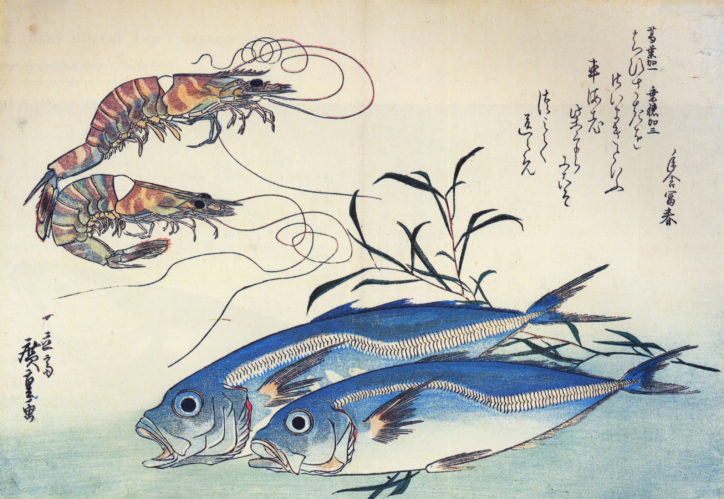
(“Horse Mackerel, Freshwater Prawns, and Seaweed”. Utagawa Hiroshige. 1832-1833.)
12 fish species of 3 subfamilies inhabit the Adriatic Sea.
The Naucratinae subfamily comprises 5 genera. The following representatives of three genera inhabit the Adriatic:
Campogramma is a monotypic genus with a sole representative – Campogramma glaycos. This species is spread in the eastern part of the Atlantic Ocean, enters the Mediterranean Sea and occasionally reaches the northern shores of the Adriatic.

(Vadigo. Photo by © Henk Heessen. marinespecies.org)
It is a pelagic coastal species, inhabits the depth of 15-30 meters. The maximum recorded length is 60 cm. The maximum weight is 2.8 kilograms. It feeds on fish. It has been found in the Adriatic Sea several times.
The only representative of the monotypic genus Naucrates is Naucrates ductor. It is a cleaner of sharks and rays. It feeds on ectoparasites from the surface of their bodies, as well as on the remains of food of sharks. It often follows ships for fairly long distances. It inhabits all tropical and subtropical seas.
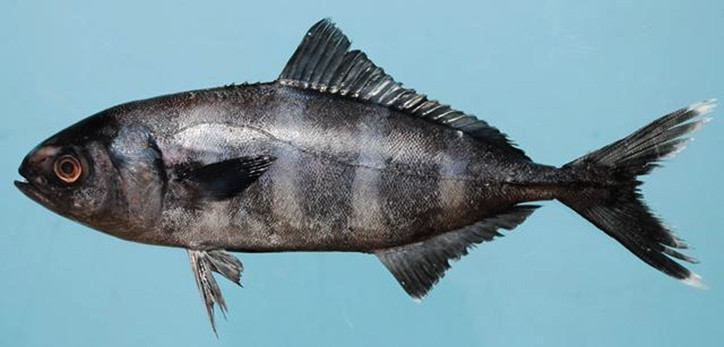
(Pilotfish. Photo by © Raju Saravanan. fishbase.org)
It inhabits the depths of up to 300 meters. The maximum recorded length is 70 cm, specimens up to 40 cm long are more common. It accompanies sharks, rays and other large fish. It feeds on the remains of their food, as well as small fish and invertebrates. It is a permanent infrequent inhabitant of the Adriatic Sea.
The Seriola genus comprises 9 living fish species, which are better known by their name “amberjacks”. They inhabit the waters of the Atlantic, Indian and Pacific Oceans. They are large predators, which are popular both among fishermen (due to their powerful struggling while playing) and admirers of dishes prepared from this fish (sushi, in particular). The largest fish of the Seriola genus, inhabiting the Adriatic, is:
Greater amberjack (Seriola dumerili).

(Greater amberjack. Photo © NOAA Photo Library. flickr.com/photos/noaaphotolib)
It inhabits the depth of 1-360 meters, usually 18-72 meters. It prefers to swim above the rocky bottom. Small fish often arrange small schools. The maximum recorded length is 190 cm, specimens up to 100 cm long are more common. The maximum weight is 80.6 kg. It feeds on fish and invertebrates. It is a permanent inhabitant of the Adriatic Sea.
The Trachinotdinae subfamily comprises 2 genera. Their representatives are found in the Adriatic.
The Lichia monotypic genus is represented by a large predator – Lichia amia. It is an inhabitant of the Mediterranean Sea, the coastal waters of West and South Africa.
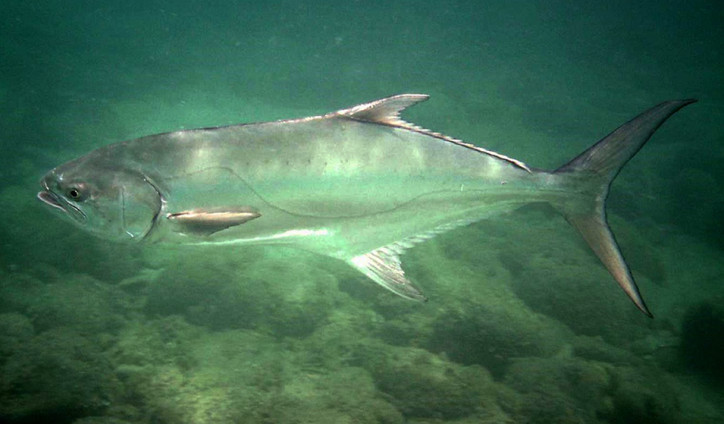
(Leerfish. Photo by © Giorgio Vittone. juzaphoto.com)
It is a pelagic coastal species, inhabiting the depths of up to 50 meters. It often prefers to swim near the mouths of rivers, enters their lower reaches, likes brackish water. Small fish arrange small schools. The maximum recorded length is 200 cm; specimens up to 100 cm long are more common. The maximum weight is 50 kg. It feeds on fish. It is a permanent inhabitant of the Adriatic Sea.
Fish of the Trachinotus genus are widely spread in the tropical waters of the Atlantic, Indian and Pacific Oceans. The genus comprises 20 species. The largest of them, Trachinotus falcatus, can be more than 120 centimeters long and weigh 36 kilograms. Only one representative of the genus is found in the Adriatic Sea.
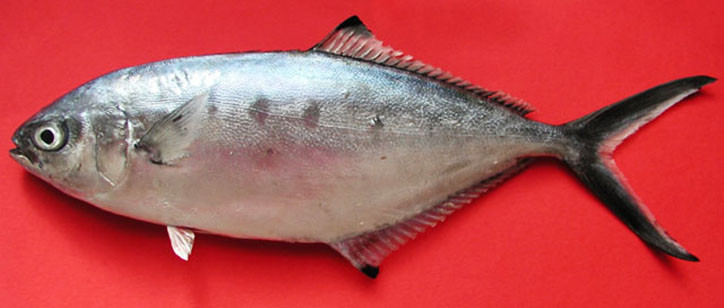
(Pompano. Photo by © Rui Patricio Freitas. fishbase.org)
It is a schooling pelagic coastal species. It inhabits the depth of 50-200 meters. Sometimes, it enters the bays, lagoons and estuaries. The maximum recorded length is 70 cm; specimens up to 35 cm long are more common. The maximum weight is 2.8 kilograms. It feeds on small crustaceans, mollusks and fish. It is a permanent inhabitant of the Adriatic Sea.
The Caranginae subfamily comprises 22 genera. 4 of them are found in the Adriatic Sea.
Representatives of the Alectis genus are large predatory fish inhabiting the Atlantic, Indian and Pacific Oceans. The body is of high diamond shape, compressed laterally. Juveniles have distinctive filamentous spines of rays of dorsal and anal fins.
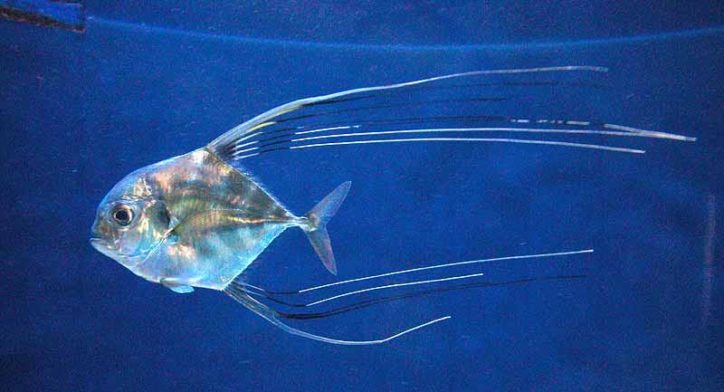
(Juvenile Alectis indica. Photo © longan62.com)
The genus comprises three species. One of them is found in the Adriatic Sea.
Alexandria pompano (Alectis alexandrina).
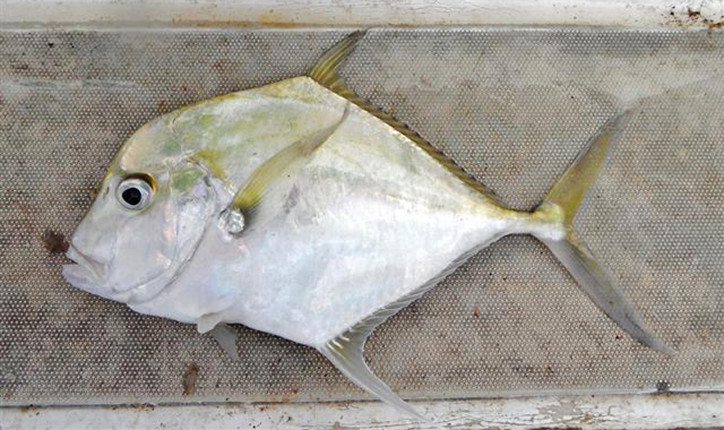
(Alexandria pompano. Photo by © Theo Modder. fishbase.org)
It is a single pelagic coastal species, inhabiting the depths of up to 70 meters, usually at least 50 meters. The maximum recorded length is 100 cm; specimens up to 60 cm long are more common. The maximum weight is 3.2 kilograms. It feeds on squid and fish. It was found several times in the southern and central part of the Adriatic Sea.
The Caranx genus comprises 18 fish species. Caranx are widely spread in the tropical and subtropical waters of the Pacific, Indian and Atlantic Oceans. They are very popular with anglers. All fishes of the genus are predators that feed on fish, crustaceans and cephalopods. The largest representative of the genus is Caranx ignobilis, which is better known throughout the world by the abbreviation from its English name – GT, giant trevally. It can be up to 170 centimeters long and weigh 80 kilograms. Two species of the Caranx genus are found in the Adriatic Sea:
Blue runner or bluestripe jack (Caranx crysos).

(Blue runner. Photo © NOAA Photo Library. flickr.com/photos/noaaphotolib)
It is a coastal schooling species, inhabiting the depths of up to 100 meters. It often prefers to swim near the rocky bottom. The maximum recorded length is 70 cm; specimens up to 40 cm long are more common. The maximum weight is 5.1 kg. It feeds on fish, shrimps and other invertebrates. It is a rare inhabitant of the Adriatic Sea.

(False scad. Photo © armacao.exblog.jp)
It inhabits the depth of 30-200 meters. It is a schooling species. It enters the bays and estuaries. The maximum recorded length is 60 cm, usually about 35 cm. The maximum weight is 1 kg. It feeds on small fish and invertebrates. It has recently appeared in the Adriatic Sea and at the moment it’s a permanent inhabitant of the sea.
The small Pseudocaranx genus comprises five fish species, which are quite large predators. Only one of them is found in the Adriatic Sea. Anglers know it by its English name – white trevally or striped jack.
White trevally or striped jack (Pseudocaranx dentex).
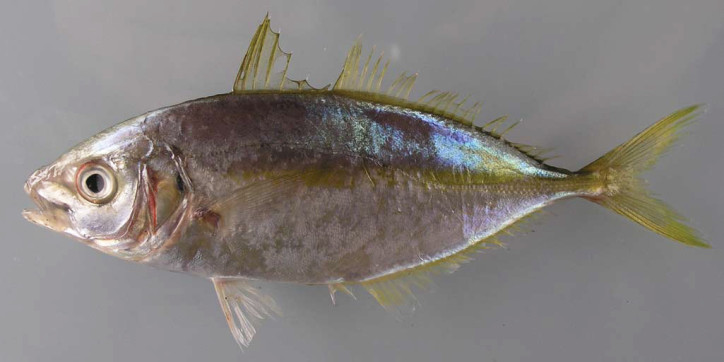
(White trevally. Photo by © Maeng Jin Kim and Choon Bok Song. Korean Journal Of Ichthyology Vol. 26, No. 4, 340-344, December 2014)
It inhabits the depth of 10-238 meters, usually 10-25 meters. It is coastal schooling species. It often enters the bays and estuaries, prefers to swim close to the irregular, often rocky bottom. The maximum recorded length is 122 cm; specimens up to 40 cm long are more common. The maximum weight is 18.1 kilograms. It feeds on fish, mollusks and crustaceans. It is a rare inhabitant of the Adriatic Sea.
The Trachurus genus comprises 14 fish species. Trachurus are one of the most popular targets of “lightweight” recreational fishing. Due to Japanese fishermen, it got its name as a separate fishing trend – あじ – “aji fishing”. Three representatives of the genus are found in the Adriatic Sea.
Mediterranean horse mackerel (Trachurus mediterraneus).

(Mediterranean horse mackerel. Photo by © Achille De Sanctis. fishbase.org)
It is a pelagic schooling species. It inhabits the depths of up to 500 meters, usually up to 250 meters. The maximum recorded length is 60 cm; specimens up to 30 cm long are more common. It feeds on fish and small crustaceans. It is a permanent inhabitant of the Adriatic Sea.
Atlantic horse mackerel or common scad (Trachurus trachurus).

(Atlantic horse mackerel. Photo by © Mariano García Rodríguez. fishbase.org)
It is a pelagic coastal species. The fish arrange large schools over the sandy bottom. They inhabit the depths of up to 1,050 meters, usually 100-200 meters. The maximum recorded length is 70 cm; specimens up to 30 cm long are more common. The maximum weight is 2 kilograms. It feeds on fish, crustaceans and cephalopods. It is a permanent inhabitant of the Adriatic Sea.
Blue jack mackerel (Trachurus picturatus).
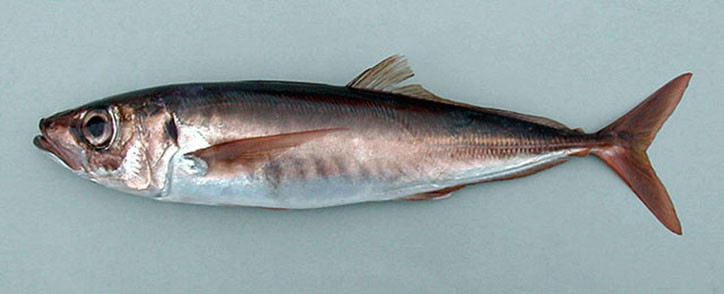
(Blue jack mackerel. Photo © Pedro Niny Duarte(c)ImagDOP. fishbase.org)
It is a pelagic schooling species. It inhabits the depth of 305-370 meters. It prefers to swim over the irregular bottom. The maximum recorded length is 60 cm; specimens about 25 cm long are more common. It feeds on crustaceans and small fishes. It is a permanent inhabitant of the Adriatic Sea, which is more often found in the southern part of the Sea.